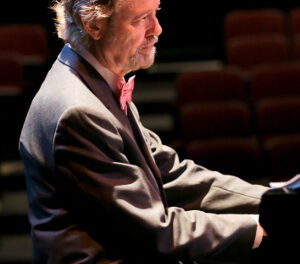Impresario John O’Brien, the face, voice, brains, and dogsbody of the Music House in Greenville, always breaks the artistic dry spell of summer in eastern Carolina by organizing a multi-day festival, a delightful banquet of music. The harbinger of this feast was a teaser concert the previous Saturday; you can read about that event here.
The feast continued with Ensemble Collina; they bill themselves as a “musical genre in Chapel Hill.” The prime movers are Michael Kris and Leah Peroutka, both of whom performed in Greenville, accompanied by John O’Brien.
Sackbut is a funny word; everybody finds the merest mention amusing. But few know what a sackbut is – a medieval-to-renaissance-to-baroque trombone. Yes, a pure and simple trombone (and just for fun, trombone is actually the older word). The diameter of the tube varies, the shape of the bell varies, the thickness of the metal varies, but it’s a trombone.
In its sackbut variations, the instrument is capable of using its indoor voice and blending well with voices and indoor solo instruments such as violin. This program consisted of fourteen movements by sackbut, violin, and organ.
The keyboard instrument used in this performance was a delicate domestic scale organ with five stops, not the usual church instrument with huge pipes, multiple keyboards, and pedals.
Fourteen movements with identical instrumentation sounds like a dance band or a musicological lecture/demonstration; only the artistry of the players set this apart from a lecture, although there were some interesting remarks by Kris. Kris also worked hard to breathe some life into his parts, not an easy feat on the sackbut.
While all this early baroque music was interesting, the ensemble had some difficulty pulling together at the beginning. This was particularly obvious in the first piece, a Sonata a due by Giovanni Valentini; Kris was pretty consistently behind the beat. This may have been complicated by the extreme syncopations of the composition.
Next were three Canzoni a due of 1620 by Giovanni Battista Riccio. In the first, “La fineta,” Peroutka’s violin led the merry chase. In the third, “La pichi,” the dynamic range of both the sackbut and the violin was exploited in a series of echo passages. Here, the extreme delicacy of Peroutka’s violin playing was delightful and distinctive.
After intermission Giovanni Picchi‘s Canzon terza of 1625 was remarkably well played by all. The extreme disjunct nature of the themes was precisely handled.
A Capriccio a due (1610) by Giovanni Andrea Cima was described as remarkable for its antique style. The succeeding Sonata a due by Giovanni Paolo Cima was in the modern style. Kris was precisely with the organ and violin – there was none of the previous lagging.
The program closed with three of Adam Jarzębski‘s Concerti a due of 1672 – Primo, Secunda, Terza.
The program was pleasant enough, but even with the best will in the world, I was unable to get past the dry pedagogical nature of both the playing and the spoken notes.
Note: Links to these composers are from the wonderful IMSLP, a godsend for musicians and critics alike. Let’s hear it for the internet!











